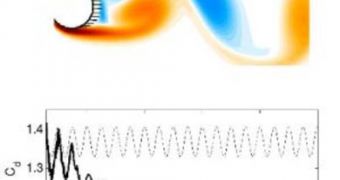Over millions of years of evolution, birds have managed to develop a highly efficient flight system, in which they use two types of feathers to fly. The longer, more stiff flight feathers help generate lift, while the second ones, coverts, are used to minimize drag while moving through the air. A team of Italian scientists has demonstrated that, by coating the rigid wings of a plane in a material mimicking the structure and size of the feathers, the drag experienced by the craft could be reduced by as much as 15 percent, as opposed to having no such cover.
In charge of the new research has been University of Genoa expert Alessandro Bottaro, who has created a computer model of a cylinder and then has modeled bristles that look and act like bird covert feathers. He has, consequently, inserted the model in an artificial wind tunnel, and has observed how air flows over the cylinder. The team has concluded that drag has been considerably diminished, when air flows have started making the coverts wobble in the air, NewScientist reports.
When large, modern aircraft fly, they generate a great deal of disturbances in the air, behind their wings, mostly because once the air moves past the wings, it creates an area of low pressure. In this area, vortices that form increase the drag that the airplane has to get through in order to take off. More effort on the part of the plane translates into more used fuel and less weight. The effect can also be seen in race cars, when a vehicle moves in the back of another in front, so as not to experience the drag that slows the first car down.
But the artificial bristles in the new experiments have managed to cancel this effect, by vibrating once air came off the end of the cylinder. This has allowed for a smoother air flow, and has prevented vortices from appearing. No vortices have made for a more efficient flight, and the experts have calculated that these additions increase the overall flight efficiency of the virtual model by 15 percent.
They envision the system being used on future airplanes, or even on existing ones, if companies wish to pay the extra costs. However, they themselves admit that the bristles cannot be operated without devising a self-cleaning mechanism that would ensure they always perform at optimum performances. In birds, coverts are always cleaned, but an airplane that flies around the world may need another type of cleaning.

 14 DAY TRIAL //
14 DAY TRIAL //